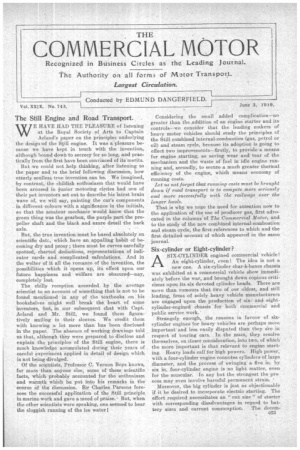Six - cylinder or Eight - cylinder?
Page 1

Page 2

If you've noticed an error in this article please click here to report it so we can fix it.
SIX-CYLINDER engined commercial vehicle !
An eight-cylinder, even! The idea is not a, new one, A six-cylinder char-h-bancs chassis was exhibited at a commercial vehicle show immediately before the war, and brought down copious criticisms upon its six devoted cylinder heads. There are more than rumours that two of our oldest, and still leading, firms of solely heavy vehicle manufacturers are engaged upon the production of sixand eightcylinder-engined chassis for both commercial and public service work. Strangely enough, the reasons in favour of sixcylinder engines for heavy vehicles are perhaps more important and less easily disputed than they are in respect of touring cars. In the main, they resolve themselves, on closer consideration, into two, of which the more important is that relevant to engine starting. Heavy loads call for high powers. High power, with a four-cylinder engine connotes cylinders of large diameter, and the process of swinging a five in. by six in. four-cylinder engine is no light matter, even for the muscular. In any but the strongest the process may even involve harmful permanent strain. • • Moreover, the big cylinder is just as objectionable if it be desired to incorporate electric starting. The effort required necessitates an " out size " of starter with corresponding disadvantages in regard to battery sizes and current consumption. The decom
pressor, or half compression gear, which affords relief when starting, does not appear to be received very favourably. In. other words, it has not "caught on. '
The use of an engine with more than four cylinders brines the matter on to another, plane entirely. Four cylinders of 5 in, bore could be replaced by six of slightly over 4 in. bore. The effort required to turn would be two-thirds of that called for by the f ourcylinder unit, offering, therefore. advantages in respect of hand-starting, and paving the way for the introduction of the electric starter on heavy vehicles, and we should add that this is an innovation which will need considerable encouragement.
The disadvantages of the sixand eight-cylinder engine (apart from the possibility of excessive crankshaft vibration from the former, and carburation difficulties in both, as these can both be overcome) are probably, in the main, confined to expense and complication. The latter is really covered by the former in the sense that the greater contains the lesser. The problem involved is that of equating advantages and costs. Evidently. the two firms which we have in mind are of opinion that the former outweigh the latter. They are at least to be complimented on their progressive policy.






















